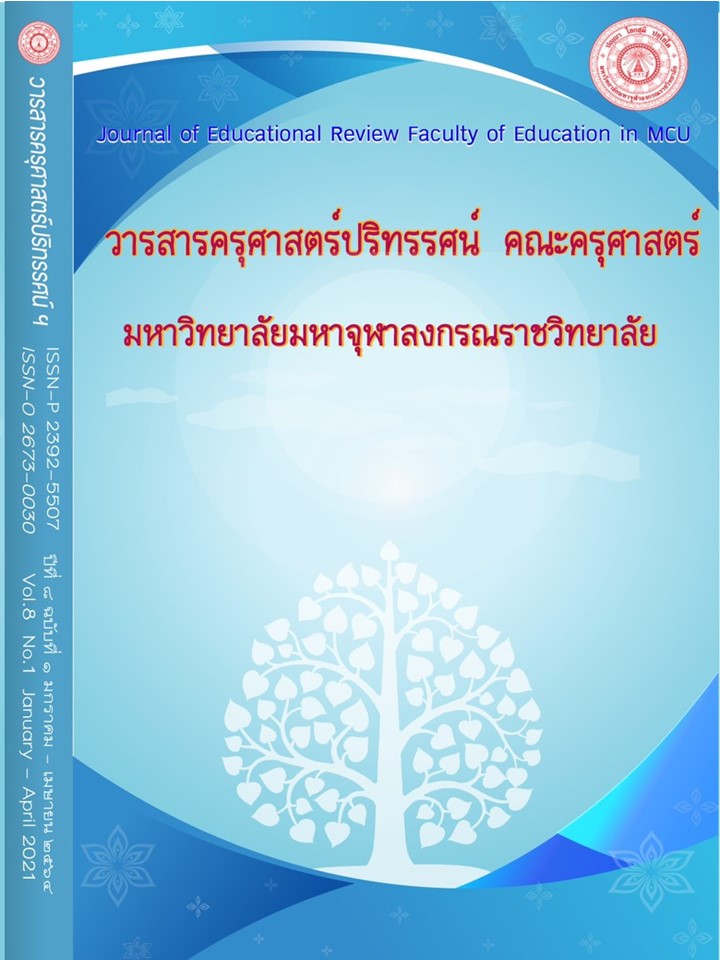THE TRAINING MODEL FOR BUDDHIST NEWLY ORDAINED MONKS IN THAILAND
Main Article Content
Abstract
The objective of this research paper was to propose the training model for Buddhist newly ordained monks in Thailand. Mixed methods research was designed consisting 3 steps which were 1) study the current condition and problems of training Buddhist newly ordained monks by using documentary study and interview with 5 key informants. 2) Developed the model by using focus group discussion of 9 experts. 3) Proposed the model using the model evaluation model with 397 samples. The statistics used in the research were percentage, mean and standard deviation. Research results found that training model for Buddhist newly ordained monks in Thailand consisted of 3 parts: part 1, the introduction part consists of principles, objectives and context of the temple for training Buddhist newly ordained monks. Part 2 guideline for training management of Buddhist newly ordained monks which were 1) Five aspects of training composition, namely (1) personnel aspects: the master teacher / lecturer, mentor and trainee, (2) resources aspect: place and time, (3) courses and activities, (4) budget, (5) management and management of training programs. 2) Stages of training activities which were preparation, implementation and evaluation. Part 3, the conditions for the implementation of the model. In summary, the research knowledge is POE-PRCBM.
Article Details
ทัศนะและความคิดเห็นที่ปรากฏในบทความในวารสารฉบับนี้ถือเป็นความรับผิดชอบของผู้เขียนบทความนั้นเพียงผู้เดียว และไม่ถือเป็นทัศนะและความรับผิดชอบของกองบรรณาธิการ
กองบรรณาธิการขอสงวนสิทธิ์ในการคัดเลือกบทความลงตีพิมพ์และจะแจ้งให้เจ้าของบทความทราบหลังจากผู้ประเมินบทความตรวจอ่านบทความแล้ว
ต้นฉบับที่ได้รับการตีพิมพ์ในวารสารครุศาสตร์ปริทรรศน์ คณะครุศาสตร์ มหาวิทยาลัยมหาจุฬาลงกรณราชวิทยาลัย ถือเป็นกรรมสิทธิ์ของคณะครุศาสตร์ มหาวิทยาลัยมหาจุฬาลงกรณราชวิทยาลัย ห้ามนำข้อความทั้งหมดหรือบางส่วนไปพิมพ์ซ้ำ เว้นเสียแต่ว่าจะได้รับอนุญาตจากมหาวิทยาลัยฯ เป็นลายลักษณ์อักษร
References
ชาญณรงค์ บุญหนุน. (2554). การลดจำนวนของพระสงฆ์และผลกระทบต่อพระพุทธศาสนาในอนาคต. วารสารพุทธศาสน์ศึกษา จุฬาลงกรณ์มหาวิทยาลัย. 18(3). 7-24.
ทิศนา แขมมณี. (2545). รูปแบบการเรียนการสอน: ทางเลือกที่หลากหลาย. กรุงเทพมหานคร: สำนักพิมพ์แห่งจุฬาลงกรณ์มหาวิทยาลัย.
ไทยพับลิก้า. (2013). สถิติชี้จำนวนวัดเพิ่มขึ้นปีละ 300 วัด! ยุครุ่งเรืองของศาสนาแล้วจริงหรือ. แหล่งที่มา https://thaipublica.org/2013/12/monastery-institution-2/ สืบค้นเมื่อ 3 ม.ค. 2562.
พระปราโมทย์ วาทโกวิโท และพระมหาหรรษา ธมฺมหาโส. (2562). รูปแบบการพัฒนาวิทยากรต้นแบบสันติภาพโดยพุทธสันติวิธี. วารสารสันติศึกษาปริทรรศน์ มจร. 7 ฉบับเพิ่มเติม. S253-S265.
พระมหากิตติพัฒน์ ศรีนาค. (2550). แนวโน้มวิกฤตพระสงฆ์ศาสนทายาทเนื่องด้วยการบวชในสังคมไทยปัจจุบัน ศึกษาเฉพาะกรณีการบวชระยะสั้นของพระสงฆ์ในกรุงเทพมหานครและจังหวัดราชบุรี. วิทยานิพนธ์ศิลปศาสตรมหาบัณฑิต. มหาวิทยาลัยมหิดล.
พระมหาเกรียงไกร เกริกชัยวัน. (2554). กระบวนการคัดเลือกและวิธีการฝึกอบรมพระอุปัชฌาย์ของคณะสงฆ์ไทย. วิทยานิพนธ์ศิลปศาสตรมหาบัณฑิต. มหาวิทยาลัยธรรมศาสตร์.
พระมหาไกรวรรณ์ ชินทตฺติโย และคณะ .(2562). การวิจัยและพัฒนาหลักสูตรฝึกอบรมพระวิทยากรกระบวนธรรม. วารสารสันติศึกษาปริทรรศน์ มจร. 7 ฉบับเพิ่มเติม. S281-S297.
พระมหาปฐวีศักดิ์ ร่มโพธิ์ธารทอง. (2554). พระนวกะ: การพัฒนาหลักสูตรฝึกอบรมเพื่อสืบสานพระพุทธศาสนาในกรุงเทพมหานคร. ดุษฎีนิพนธ์ปรัชญาดุษฎีบัณฑิต. มหาวิทยาลัยมหาสารคาม.
พระมหาภานุวัฒน์ ลุใจคำ และปริญญภาษ สีทอง. (2563). การพัฒนาหลักสูตรเตรียมความพร้อมเพื่อเป็นพระธรรมทูตสำหรับสามเณร. วารสารวิทยาลัยสงฆ์นครลำปาง. 9(1). 10-20.
ราชบัณฑิตยสถาน. (2556). พจนานุกรมฉบับราชบัณฑิตยสถาน พ.ศ. 2554. กรุงเทพมหานคร: นานมีบุ๊คส์พับลิเคชั่นส์.
สิริกาญจน์ ธนวุฒิพรพินิต ณรงค์ พิมสาร และบังอร โกศลปริญญานันท์. (2563). หลักสูตรฝึกอบรมการประกันคุณภาพการศึกษาภายนอก ระดับการศึกษาขั้นพื้นฐาน. วารสารครุศาสตร์ปริทรรศน์ คณะครุศาสตร์ มหาวิทยาลัยมหาจุฬาลงกรณราชวิทยาลัย. 7(1). 121-131.


